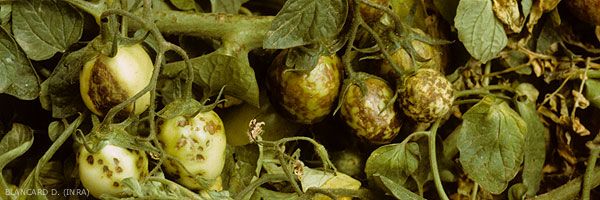
Alfalfa mosaic virus
(AMV)
Alfalfa mosaic virus
,
,
- classification : Bromoviridae, Alfamovirus
The alfalfa ( mosaic virus Alfalfa mosaic virus , AMV) probably has a global distribution, but it occurs more frequently in temperate regions , where alfalfa is cultivated (this plant being a preferred host of this virus). It is also present in warmer regions , in Africa and America, where various legumes, chilli and tomato are grown. AMV is not considered to be a major tomato virus in the Americas. On the other hand, it is regularly observed in field crops in southern Europe, but with large differences in frequency depending on the plot and the year.
This virus occurs occasionally on tomatoes in France , and mainly in the open field. It is found on alfalfa, tobacco, but also on other vegetable crops and on aromatic plants. Serious attacks have sometimes been observed in plots of tomatoes intended for industry and grown near alfalfa. In this case, almost 80% of the plants showed symptoms. If the attacks are early, plant growth is severely affected. The number of fruits is often reduced, and their quality strongly depreciated.
AMV was first reported on alfalfa ( Medicago sativa ) in the United States in 1931. It is the type species of the genus Alfamovirus (Figure 1) and belongs to the family of Bromoviridae, like Cucumovirus, Bromovirus and Ilarvirus. .
 |
| Figure 1 |
Numerous strains or variants of AMV have been described, showing minor differences in their thermal sensitivity, their possibility of transmission by pollen and seed, and the differential reactions of a few inoculated hosts. By way of example, let us mention the strains AMV-S from alfalfa, AMV 425 isolated from clover, and yellow spot mosaic (YSMV).
The virions have a variable shape. The smallest are isometric, with a diameter of 18 nm, the others are bacilliform; their variable lengths are 29, 38, 49 and 58 nm.





